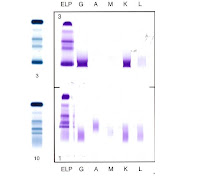0705365e
Hi again...........
Very sorry for the late post...
Cytology laboratory has 2 different departments; Gynaecology and Non-Gynaecology department.
Non-Gynae deals with all kinds of liquid specimens that come from different part of the body, for example; knee aspirate, sputum, urine, FNA fluid from the breast, thyroid or parotid, and pleural fluid. Thus, as intern, i wasnt allow to handle these potential biohazardous materials except for my own urine, and sputum.
Gynae department receives Pap smear materials which come in 2 different method; as conventional slides and in ThinPrep vials.
As the term refers, conventional slides are slides that are already smeared with the materials/specimens and been spray-fixed to protect the cells from any damages by providing a waxy-cover. After properly received, the slides are to be place in 95% ethanol for around 10 mins to remove the coating so as to allow good penetration of dyes during staining. Then they are manually transferred to the automated staining machine for Papanicolaou stain.
 Source: http://www.marketingvp.com/payback/cytyc/results.htm
Source: http://www.marketingvp.com/payback/cytyc/results.htmPicture 1: Example of conventional Pap smear slides. The slides received are pre-smeared and spray-fixed.
Specimens that comes in vials (ThinPrep is the commercial name) are gynaecologic samples that are being collected by the clinician using sampling device which is then immersed and rinsed in the vial filled with PreservCyt solution (solution that acts as a preservative). Instead of being smeared on slide then send to cyto lab (conventional slide), the specimen is sent in solution form and so, it has to be prepared on slide first before staining.

Source: http://www.wcpl.com/physician_supplies.asp
Picture 2: Example of specimen vial that is received in cyto lab. The vial contains gynaecologic materials that have been immersed in the solution.
For specimens that are received in ThinPrep vials have to be prepared on slides before staining them to allow easy screening.The vials are placed in ThinPrep 2000 processor that makes use of mechanical, pneumatic and fluidic principles for cell dispersion, collection and tranfer. This processor makes a relatively thin smear of the specimen materials that covers a specific area of the slides.
 Source: httpwebsites.labx.comrankindetail.cfmautonumber=50949
Source: httpwebsites.labx.comrankindetail.cfmautonumber=50949
Picture 3: ThinPrep 2000 processor.
The processor initiates a gentle dispersion of the PreserCyt solution that contains patient's material, this will break up blood, mucus, non-diagnostic debris and thoroughly mixes the cell sample. The cell are then collected on a TransCyt Filter specifically designed to collect diagnostic cells. The processor constantly monitors the rate of flow through the fliter during the collection process to control or determine the cellular presentation on the slides; from being too thick or scant. A thin layer of cells is then transferred to a glass slide in a 20mm-diameter circle and the slide is automatically deposited into a fixative solution of 95% alcohol.
ThinPrep processor mainly involves 3 principles.
1. Dispersion of cells; to separate debris and disperse mucus but gives no adverse effect on the cell appearance.
2. Cell collection; diagnostic cells are picked up (by a gentle vacuum) and collected onto the filter membrane.
3. Cell transfer; the collected cells on the membrane are transferred onto a glass slide by gently pressing them onto the surface of the slide. Natural attraction and slight positive air pressure cause the cells to adhere to the microscopic slides resulting in an even distribution of cell in as defined circular area.

Source: http://ssp-labs.com/cytology.html
Picture 4: ThinPrep slides with a defined circular area of cells; processed using the ThinPrep processor.






